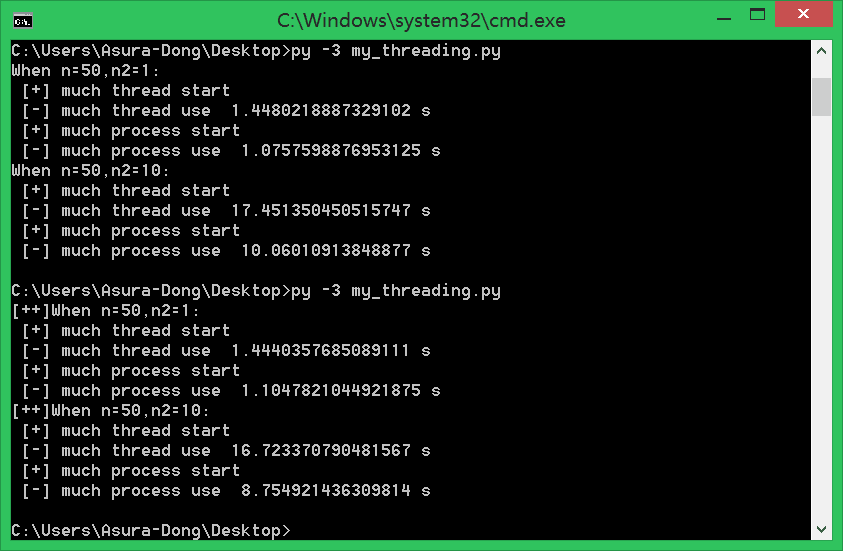Python IO密集型任务、计算密集型任务,以及多线程、多进程 - tsw123 - 博客园
https://www.cnblogs.com/tsw123/p/9504460.html
Python IO密集型任务、计算密集型任务,以及多线程、多进程选择
对于IO密集型任务:
- 单进程单线程直接执行用时:10.0333秒
- 多线程执行用时:4.0156秒
- 多进程执行用时:5.0182秒
说明多线程适合IO密集型任务。
对于计算密集型任务
- 单进程单线程直接执行用时:10.0273秒
- 多线程执行用时:13.247秒
- 多进程执行用时:6.8377秒
说明多进程适合计算密集型任务。
| 1 2 3 4 5 6 7 8 9 10 11 12 13 14 15 16 17 18 19 20 21 22 23 24 25 26 27 28 29 30 31 32 33 34 35 36 37 38 39 40 41 42 43 44 45 46 47 48 49 50 51 52 53 54 55 56 57 58 59 60 61 62 63 64 65 66 67 68 69 70 71 72 73 74 75 76 77 78 79 80 81 82 83 84 85 86 87 88 89 90 91 92 93 94 95 96 97 98 99 100 101 102 103 104 105 106 |
|
参考:https://zhuanlan.zhihu.com/p/24283040
=========================================================
=========================================================
=========================================================
Python多线程和多进程谁更快? - 张玉宝 - 博客园
https://www.cnblogs.com/zhangyubao/p/7003535.html
python多进程和多线程谁更快
- python3.6
- threading和multiprocessing
- 四核+三星250G-850-SSD
自从用多进程和多线程进行编程,一致没搞懂到底谁更快。网上很多都说python多进程更快,因为GIL(全局解释器锁)。但是我在写代码的时候,测试时间却是多线程更快,所以这到底是怎么回事?最近再做分词工作,原来的代码速度太慢,想提速,所以来探求一下有效方法(文末有代码和效果图)
这里先来一张程序的结果图,说明线程和进程谁更快
一些定义
并行是指两个或者多个事件在同一时刻发生。并发是指两个或多个事件在同一时间间隔内发生
线程是操作系统能够进行运算调度的最小单位。它被包含在进程之中,是进程中的实际运作单位。一个程序的执行实例就是一个进程。
实现过程
而python里面的多线程显然得拿到GIL,执行code,最后释放GIL。所以由于GIL,多线程的时候拿不到,实际上,它是并发实现,即多个事件,在同一时间间隔内发生。
但进程有独立GIL,所以可以并行实现。因此,针对多核CPU,理论上采用多进程更能有效利用资源。
现实问题
在网上的教程里面,经常能见到python多线程的身影。比如网络爬虫的教程、端口扫描的教程。
这里拿端口扫描来说,大家可以用多进程实现下面的脚本,会发现python多进程更快。那么不就是和我们分析相悖了吗?
import sys,threading
from socket import *
host = "127.0.0.1" if len(sys.argv)==1 else sys.argv[1]
portList = [i for i in range(1,1000)]
scanList = []
lock = threading.Lock()
print('Please waiting... From ',host)
def scanPort(port):
try:
tcp = socket(AF_INET,SOCK_STREAM)
tcp.connect((host,port))
except:
pass
else:
if lock.acquire():
print('[+]port',port,'open')
lock.release()
finally:
tcp.close()
for p in portList:
t = threading.Thread(target=scanPort,args=(p,))
scanList.append(t)
for i in range(len(portList)):
scanList[i].start()
for i in range(len(portList)):
scanList[i].join()谁更快
因为python锁的问题,线程进行锁竞争、切换线程,会消耗资源。所以,大胆猜测一下:
在CPU密集型任务下,多进程更快,或者说效果更好;而IO密集型,多线程能有效提高效率。
大家看一下下面的代码:
import time
import threading
import multiprocessing
max_process = 4
max_thread = max_process
def fun(n,n2):
#cpu密集型
for i in range(0,n):
for j in range(0,(int)(n*n*n*n2)):
t = i*j
def thread_main(n2):
thread_list = []
for i in range(0,max_thread):
t = threading.Thread(target=fun,args=(50,n2))
thread_list.append(t)
start = time.time()
print(' [+] much thread start')
for i in thread_list:
i.start()
for i in thread_list:
i.join()
print(' [-] much thread use ',time.time()-start,'s')
def process_main(n2):
p = multiprocessing.Pool(max_process)
for i in range(0,max_process):
p.apply_async(func = fun,args=(50,n2))
start = time.time()
print(' [+] much process start')
p.close()#关闭进程池
p.join()#等待所有子进程完毕
print(' [-] much process use ',time.time()-start,'s')
if __name__=='__main__':
print("[++]When n=50,n2=0.1:")
thread_main(0.1)
process_main(0.1)
print("[++]When n=50,n2=1:")
thread_main(1)
process_main(1)
print("[++]When n=50,n2=10:")
thread_main(10)
process_main(10)
结果如下:
可以看出来,当对cpu使用率越来越高的时候(代码循环越多的时候),差距越来越大。验证我们猜想(在CPU密集型任务下,多进程更快,或者说效果更好;而IO密集型,多线程能有效提高效率。)
CPU和IO密集型
- CPU密集型代码(各种循环处理、计数等等)
- IO密集型代码(文件处理、网络爬虫等)
判断方法:
- 直接看CPU占用率, 硬盘IO读写速度
- 计算较多->CPU;时间等待较多(如网络爬虫)->IO
- 请自行百度
参考
为什么在Python里推荐使用多进程而不是多线程?
如何判断进程是IO密集还是CPU密集
搞定python多线程和多进程